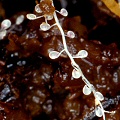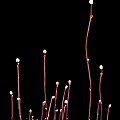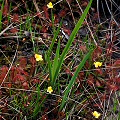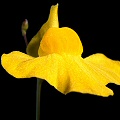| Utricularia section Setiscapella | ||
|---|---|---|
| Species | Range | Habit1 |
| U. flaccida | Brazil | T |
| U. nervosa | South America | T |
| U. nigrescens | Brazil | T |
| U. physoceras | Brazil | T |
| U. pusilla | Central and South America, Antilles | T |
| U. stanfieldii | w tropical Africa | T |
| U. subulata | pan-tropical | T |
| U. trichophylla | Central and South America | T/AA |
| U. triloba | Central and South America | T |
| 1T=terrestrial; AA=affixed aquatic. | ||
Q: About Utricularia subgenus Utricularia section Setiscapella
A: A moderately large group of species that have egg-shaped, striated seeds unlike
any other species in the genus. Not something exactly worth writing home about, I admit, but it merits a separate section.
Let me tell you a little story. When I was first starting to grow carnivorous plants, years and years ago (yes, it was even before
the internet) (I imagine my younger readers pondering the previous parenthetical with slack jaws, glazed eyes, mouthing wordlessly,
as they try to imagine a world without an internet....without....YouTube!). Anyway, my entire carnivorous plant collection
consisted of a 20-liter terrarium containing two Sarracenia purpurea, five Dionaea,
and two small Drosera capillaris. Poking up here and there were little grasslike plants which produced
tiny, threadlike stalks that bore tiny little globes on their tips. Magically, the globes would split and seeds would dribble out.
When I discovered---by reading through one of my carnivorous plant books---that the little grassy plant was actually another
carnivorous plant, Utricularia subulata, I was thrilled! A bladderwort all my own! I coddled it and
cared for it, and in time it grew into a healthy vigorous plant. I tell you this just so you have a counterpoint to the
continual complaints you get from growers about this species. Others may find it boring, I still think it is delightful.
Utricularia subulata
To the right you can see this little species. It has very pretty, tiny yellow
flowers on erect wiry scapes. They dance on the wind like tiny insects. But because the little species is so friggin' common,
people discount them out of familiarity. I discourage this attitude as it is the same perspective that encourages infidelity in
one's marriage. If conditions are not ideal, this species will not produce its little yellow flowers.
Instead it produces tiny spherical flowers that have no petals! These globular little things are called cleistogamous
flowers (meaning they are closed, hidden, without petals). Sealed from pollinators, they self pollinate and subsequently
open and spill forth precious seed.
This is another reason people do not like them---they are weedy. Still, I think its a great
little species.
The species Utricularia cochleata C.P.Bove is possibly a misidentification of this species.

U. triloba
This species has the largest range of all the plants in the genus. In the USA, it is found in just about every
eastern state south of Massachusetts that has an oceanic coastline, as well as a few others.
Utricularia triloba
A species that is very similar in appearance to
Utricularia subulata. I mention it only because I have a fairly nice picture of its little
terrestrial bladders I wanted to show you. If you look closely, you can see they have little purple tips.
Page citations: Rice, B.A. 2006a; Taylor, P. 1989; personal observations.



